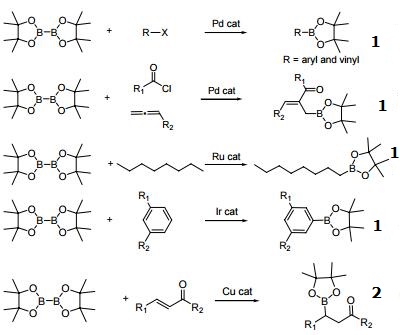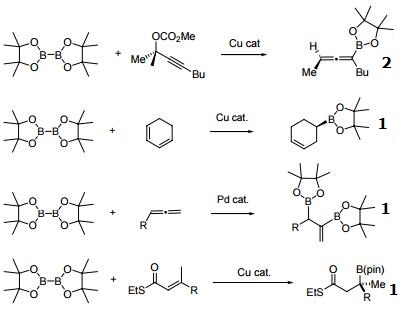| Identification | More | [Name]
Bis(pinacolato)diboron | [CAS]
73183-34-3 | [Synonyms]
4,4,4',4',5,5,5',5'-OCTAMETHYL-2,2'-BI-1,3,2-DIOXABOROLANE
4,4,4',4',5,5,5',5'-OCTAMETHYL-2,2-BI-1,3,2-DIOXABOROLANE
4,4,4',4',5,5,5',5'-OCTAMETHYL-2,2'-BIS(1,3,2-DIOXABOROLANE)
4,4,4',4',5,5,5',5'-OCTAMETHYL-2,2'-BL-1,3,2-DIOXABOROLANE
4,4,5,5,4',4',5',5'-OCTAMETHYL-[2,2']BI[[1,3,2]DIOXABOROLANYL]
BIS(2,2,3,3-TETRAMETHYL-2,3-BUTANEDIONATO)DIBORON
BIS(PINACOLATO)DIBORANE
BIS(PINACOLATO)DIBORON
DIBORON PINACOL ESTER
BIS(DINACOLATO)DIBORON
Bis(pinacolato)diboron,min.98%
Bis(pinacolate)diboron
BIS(PINACALATO)DIBORON
Bis(pinacolato)diboron, min. 98%
Bis(pinacolato)diboron, 98+% | [EINECS(EC#)]
615-925-0 | [Molecular Formula]
C12H24B2O4 | [MDL Number]
MFCD00799570 | [Molecular Weight]
253.94 | [MOL File]
73183-34-3.mol |
| Chemical Properties | Back Directory | [Appearance]
white crystal powder | [Melting point ]
137-140 °C(lit.)
| [Boiling point ]
222.6±7.0 °C(Predicted) | [density ]
0.98 | [storage temp. ]
0-6°C | [solubility ]
Chloroform (Slightly), Methanol (Slightly) | [form ]
Powder or Platelets | [color ]
White | [Water Solubility ]
Soluble in tetrahydrofuran, dichloromethane, toluene, hexane and heptane. Insoluble in water. | [Sensitive ]
moisture sensitive | [Detection Methods]
GC,NMR | [Merck ]
1300 | [BRN ]
7703552 | [InChIKey]
IPWKHHSGDUIRAH-UHFFFAOYSA-N | [CAS DataBase Reference]
73183-34-3(CAS DataBase Reference) |
| Safety Data | Back Directory | [Hazard Codes ]
Xi,Xn | [Risk Statements ]
R36/37/38:Irritating to eyes, respiratory system and skin .
R20/21/22:Harmful by inhalation, in contact with skin and if swallowed . | [Safety Statements ]
S26:In case of contact with eyes, rinse immediately with plenty of water and seek medical advice .
S37/39:Wear suitable gloves and eye/face protection .
S36:Wear suitable protective clothing . | [WGK Germany ]
3
| [Hazard Note ]
Irritant | [TSCA ]
No | [HazardClass ]
IRRITANT, IRRITANT-HARMFUL, KEEP COLD | [HS Code ]
29209090 |
| Raw materials And Preparation Products | Back Directory | [Raw materials]
Ethyl acetate-->Sodium-->PETROLEUM ETHER-->Toluene-->Cyclohexane-->Pentane-->Pyrrolidine-->Boron tribromide-->Pinacol-->TETRAKIS(PYRROLIDINO)DIBORANE 95-->2-PHENYLETHYL-1-BORONIC ACID PINACOL ESTER-->4,4,5,5-tetraMethyl-2-(1-phenylethyl)-1,3,2-dioxaborolane-->TETRAKIS(DIMETHYLAMINO)DIBORON-->3,5-Di-tert-butylcatechol-->4-tert-Butylcatechol-->Boron trichloride | [Preparation Products]
TERT-BUTYL 5-(4,4,5,5-TETRAMETHYL-1,3,2-DIOXABOROLAN-2-YL)ISOINDOLINE-2-CARBOXYLATE-->4-Nitrophenylboronic acid-->4-AMINO-3-METHOXYPHENYLBORONIC ACID, PINACOL ESTER-->4-Hydroxyphenylboronic acid pinacol ester-->(4,4,5,5-TETRAMETHYL-1,3,2-DIOXABOROLAN-2-YL)BENZENE |
| Questions And Answer | Back Directory | [Definition]
Bis(pinacolato)diboron is a covalent compound containing two boron atoms and two pinacolato ligands. It has the formula [(CH3)4C2O2B]2; the pinacol groups are sometimes abbreviated as "pin", so the structure is sometimes represented as B2pin2.
| [Uses]
It is a colourless solid that is soluble in organic solvents. It is a commercially available reagent for making pinacol boronic esters for organic synthesis. Unlike some other diboron compounds, B2pin2 is not moisture-sensitive and can be handled in air.
| [Reaction]
- Reagent used for the synthesis of aryl, alkenyl, allyl and alkylboronic esters.
- Reagent used for the borylation of an α,β-unsaturated ketones.
- Reagent used for the synthesis of precursors for conducting polymers.
- Reagent used for the synthesis of in vivo fluorescent probes.
- Reagent used for the diborylation of alkynes.



| [Preparation]
Bis(pinacolato)diboron may be prepared by reacting tetrakis(dimethylamino)diboron with pinacol in acidic conditions. The B-B bond length is 1.711(6) Å.
The B-B bond adds across alkenes and alkynes to give the 1,2-diborylated alkanes and alkenes. Using various organorhodium or organoiridium catalysts, it can also be installed onto saturated hydrocarbons: CH3(CH2)6CH3 + [pinB]2 → pinBH + CH3(CH2)7Bpin These reactions proceed via boryl complexes.
| [Suzuki reaction]
In the Suzuki reaction, Bis (pinacolato) diboron has the advantages of high reaction selectivity, mild conditions, and high yield. For some compounds that are unstable or need to improve the selectivity of the reaction, Bis (pinacolato) diboron and aryl halide are used. React is a good choice. |
| Hazard Information | Back Directory | [Chemical Properties]
Bis(pinacolato)diboron is a white crystal powder, It is commonly used coupling reagent.
| [General Description]
Bis(pinacolato)diboron or (B2pin2) is the most commonly used diborane reagent in organic synthesis due to its high stability in air and moisture. It can be synthesized by treating tetrakis(dimethylamino)diboron with pinacol in acidic conditions. |
|
|